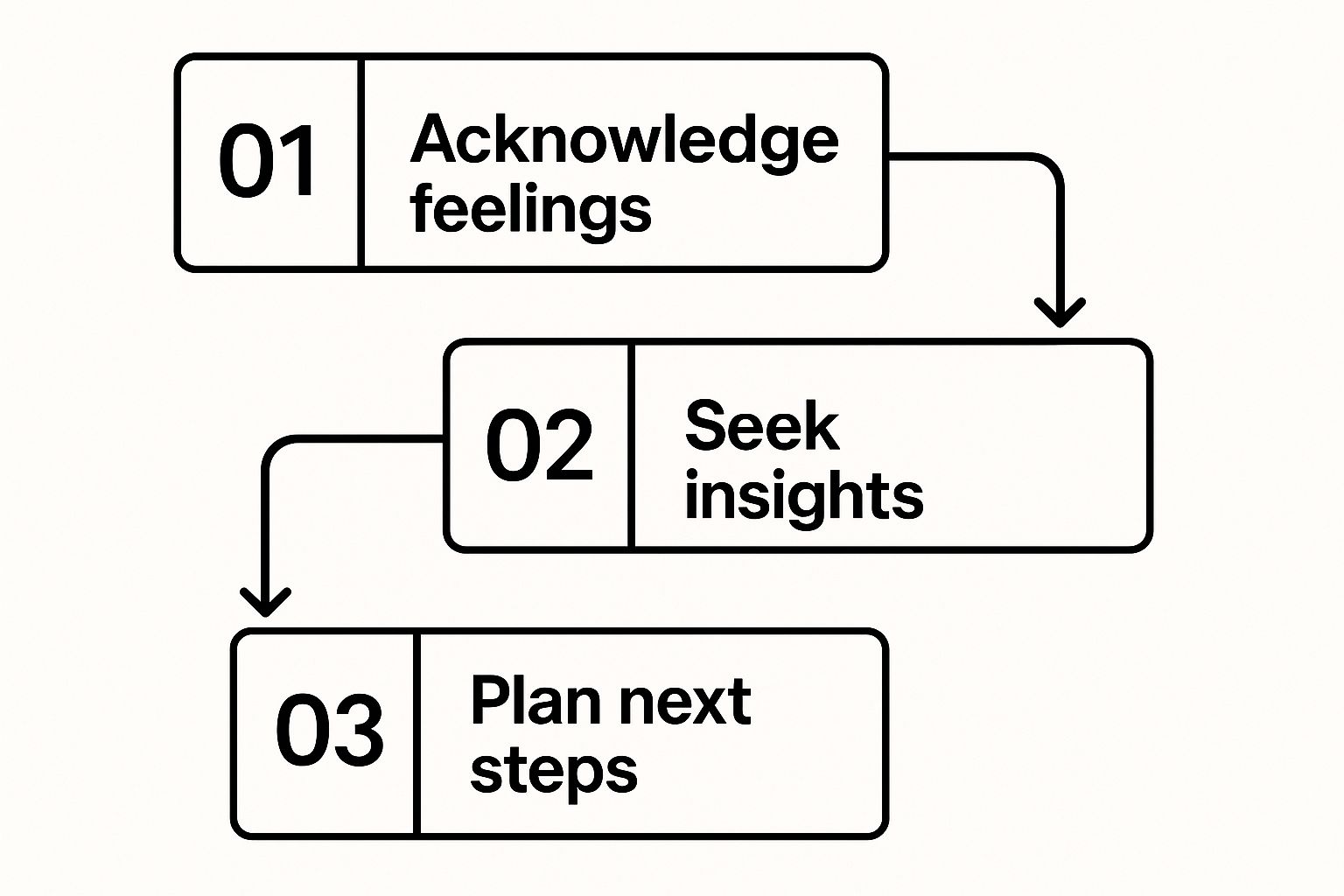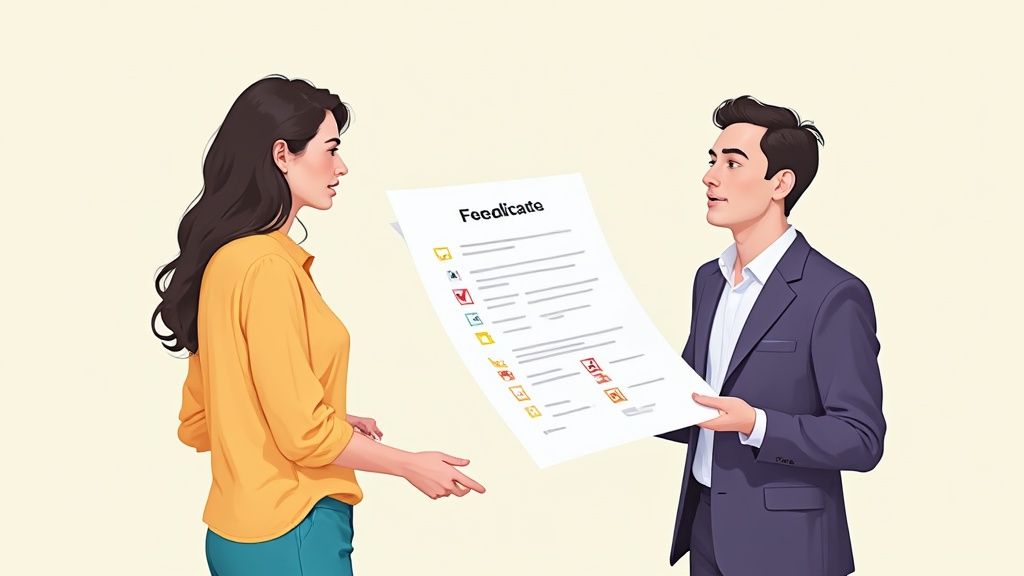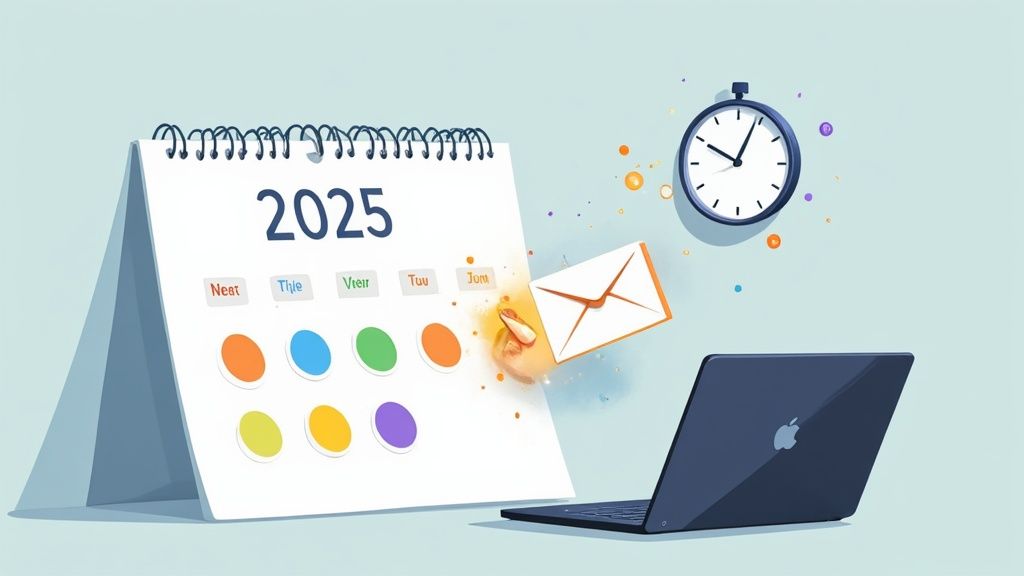How to Handle Job Rejection and Move Forward?

Getting turned down for a job is tough. Let's not pretend it isn't. The key to moving forward isn't to ignore the disappointment, but to acknowledge it, sit with it for a moment, and then channel that energy into something productive. It’s about shifting from feeling let down to gathering real-world intel for your next big opportunity.
Your First 24 Hours After a Rejection
The email arrives. "We've decided to move forward with other candidates..." Your gut sinks. Before you do anything else—before you start replaying every interview answer or spiral into self-doubt—just stop. Pause. The initial sting is completely normal, and what you do right now sets the stage for a strong comeback. The first day is all about emotional self-care, not strategy.
It's easy to take it personally. Our brains are hardwired to seek acceptance, so a rejection can feel like a direct hit to our confidence and sense of worth. The most important thing you can do is resist the urge to immediately jump into "what went wrong" mode.
Acknowledge Your Feelings and Create Some Space
Seriously, step away from the screen. Close your laptop. Put your phone on silent. Give yourself a mandatory cooling-off period, even if it’s just for an hour. This isn’t about bottling up your feelings; it's about stopping a knee-jerk emotional reaction from making your next move for you.
Do something completely unrelated that gives you a small sense of accomplishment and control. Think of it as a pattern interrupt.
- Go for a long walk or hit the gym.
- Tackle a small organization project, like tidying up your desk or a bookshelf.
- Lose yourself in a hobby you genuinely love.
These simple acts break the negative thought cycle and serve as a powerful reminder that your identity is so much more than this one job application.
Reframe the Story You're Telling Yourself
Look, getting rejected is a universal experience in any career. It's a rite of passage, not a reflection of your ultimate value. The emotional weight is real, though—studies show that almost 45% of job seekers experience significant emotional distress after a rejection.
But here's the part that really matters: The same research found that a whopping 63% of applicants who asked for feedback said it was genuinely helpful for their next interviews. This proves that taking a proactive approach can completely change the outcome. If you're curious, you can explore more about these job market dynamics to see the bigger picture.
The goal isn't to pretend it doesn't hurt. The goal is to accept the feeling, contain it, and then transform that emotional energy into productive analysis when you're ready.
To make this easier, I've put together a quick reference guide for your immediate response. Think of it as your game plan for those first crucial hours.
Your Initial Rejection Response Plan
Following these small steps helps you move from an emotional state to a logical one, which is exactly where you need to be before you start planning your next move.
This whole process is a journey from emotion to action, not a panicked scramble. This visual breaks it down perfectly.

As you can see, it all starts with managing your internal reaction. Once you have that under control, you’ll be in a much better headspace to figure out your external strategy and come back even stronger for the next opportunity.
How to Turn Rejection Into Actionable Insight

Okay, the sting of rejection is starting to wear off. What now? It's time to channel that frustration into fuel. This experience, as tough as it feels right now, is actually a goldmine of information that can make your next application ten times stronger.
The key is to shift your mindset from "What did I do wrong?" to "What can I learn?" You're not looking for reasons to blame yourself. Instead, you're putting on your detective hat to find the clues that will lead you to your next big win.
Politely Ask for Constructive Feedback
One of the most powerful things you can do is simply ask for feedback. I know, it can feel a little awkward, but the potential payoff is huge. While some companies have policies against it, you'd be surprised how many hiring managers are willing to share a few pointers if you approach them the right way.
After you've had a day or two to process the news, send a short and gracious email. Your goal is to sound appreciative and professional, not bitter.
Here’s a quick script I've seen work wonders:
Subject: Following up on the [Job Title] position
Hi [Hiring Manager Name],
Thank you again for your time and for the opportunity to learn more about the [Job Title] role and the team at [Company Name]. I really enjoyed our conversation.
As I'm always looking for ways to improve, I was hoping you might be willing to share any feedback on my interview or application. Any insights you could offer would be incredibly valuable for my professional growth.
I wish you and your team all the best in finding the perfect person for the role.
Best regards,[Your Name]
See how that feels? You come across as a mature professional who is genuinely committed to growth—a quality every single employer is looking for. If you don't get a response, don't sweat it. Just move on to the next step.
Conduct a Thorough Self-Audit
Feedback from the company is a bonus, but the real work happens when you debrief with yourself. This is your chance to get brutally honest and review every single part of your performance, from the moment you hit "apply" to your final "thank you."
Don't just vaguely think, "Maybe my interview was bad." Get specific. A methodical self-audit is what separates someone who keeps making the same mistakes from someone who gets better with every application.
Resume and Cover Letter: Go back to the job description. Did your resume scream "perfect fit" by using their exact keywords? Or was your cover letter a bit generic? You need to tell a story about why you're the only person for that specific job.
Interview Performance: Think about your answers. Were they just okay, or were they compelling? When you used the STAR method (Situation, Task, Action, Result), did you include a killer "Result" with hard numbers? If your storytelling skills feel rusty, this job interview cheat sheet is a great resource for crafting answers that stick.
Your Questions for Them: What about the questions you asked? Did they show you were just trying to get a job, or did they prove you were a strategic thinker already trying to solve their problems?
This kind of deep dive almost always uncovers something tangible. Maybe your examples were strong but lacked data. Perhaps your resume wasn't as tailored as you thought. These aren't failures—they are your roadmap for success on the very next application.
Refining Your Job Search Strategy

One job rejection is just a data point. But when you start collecting them, you’re not just unlucky—you’re seeing a pattern. That pattern is a clear signal that something in your approach needs to change. It's time to zoom out from the sting of a single "no" and take an honest, hard look at your entire job search strategy.
Are you genuinely targeting roles that play to your strengths? Or are you just carpet-bombing job boards, hoping something, anything, sticks? This is your chance to shift from dissecting one bad interview to questioning the very foundation of your search. Are the companies you’re pursuing really a good fit? Do the job titles actually match your experience level? Relying on massive online job boards alone can feel like shouting into the void. Let's change that.
Reassess Your Targeting and Channels
Your time is your most valuable asset in a job search. Wasting it on applications for mismatched roles is the fastest way to burn out. It's time to get surgical.
Take a look at your application-to-interview ratio. If you've fired off 50 applications and only heard back for one or two screening calls, your targeting is almost certainly the problem. It's not you; it's the strategy.
- Company Fit: Dig deeper than just the brand name. What's the company culture really like? Check out recent news, read employee reviews on Glassdoor, and see if their stated values feel authentic to you.
- Role Alignment: Go back and re-read the job descriptions that led to rejections. Be a detective. What are the recurring skills or qualifications you’re missing? This isn’t about making you feel inadequate; it’s about finding a clear, actionable skill gap you can start closing today.
- Channel Diversity: Your job search shouldn't live and die on LinkedIn and Indeed. A smart, modern search for how to get a corporate job means using multiple channels to get noticed.
Broaden Your Approach Beyond Just Applying
Let’s be real: the job market is incredibly competitive. It's not uncommon for a candidate to face 5 to 10 rejections before landing a great offer. But here’s the good news: proactive job seekers—the ones who keep learning and apply thoughtfully instead of blindly—see a 20% higher callback rate after a rejection. You are absolutely not alone in this.
Don't let rejection push you into a frantic cycle of doing more of the same. Use it as the catalyst to fundamentally change how you search, not just how you interview.
This means reallocating some of your energy. Shift from a purely application-focused mindset to one centered on building connections and demonstrating your value. Your next great opportunity probably won't come from an "Apply Now" button. It'll come from a conversation.
Here’s how to diversify your efforts:
- Go on "Coffee Chats": Reach out to people in roles or companies you admire. Ask for just 15 minutes of their time for an informational interview to hear about their journey. This is networking gold and gives you priceless insider knowledge.
- Network with Purpose: Stop sending random connection requests. Instead, find people at your target companies and engage with their content. Leave thoughtful comments on their posts and start building a reputation as a smart, engaged professional in your space.
- Sharpen Your Skills: Remember that skill gap you identified? Now's the time to close it. Enroll in an online course, grab a new certification, or take on a small freelance project. Not only do you learn something, but you also get a powerful new line item for your resume.
Build Professional Bridges With a Follow-Up
How you handle a "no" can honestly leave a more lasting—and positive—impression than you might think. I've seen it happen time and time again. Once that initial sting of rejection wears off, your next move is a purely strategic one. This isn't about begging for the job or questioning their decision. It's about showing them you have professionalism, foresight, and serious emotional intelligence.
A dead end can absolutely become a future opportunity if you just handle it with a bit of class.
https://www.youtube.com/embed/F7sI1MHh2q8
Sending a gracious follow-up email after they've turned you down is a surprisingly powerful move that keeps the door open. You’re signaling that you're resilient and mature—two traits that every single recruiter I know is actively searching for.
The Art of the Gracious Follow-Up
So, what's the goal here? It's simple, really. You want to thank the hiring team for their time, reiterate that you're still interested in the company itself, and subtly position yourself as a great candidate for whatever comes next. It’s a low-effort, high-impact gesture that, frankly, very few applicants bother with. That’s what instantly sets you apart.
This small step can have a huge impact. Some fascinating global hiring trends on HireBorderless.com show that candidates who respond constructively to rejection have a re-interview or rehire rate that's 15% to 25% higher than those who just ghost them. Recruiters truly value a growth mindset, and this is your chance to prove you have one.
A well-crafted note can make all the difference. If you're looking for more inspiration, our guide on writing a follow-up application letter has some great examples you can adapt.
An Email Template That Builds Bridges
Here’s a simple, effective template you can tweak. It strikes that perfect balance between genuine gratitude and forward-thinking professionalism, making sure you end the conversation on a high note.
Subject: Thank You - [Job Title]
Hi [Hiring Manager's Name],
Thanks so much for the opportunity to interview for the [Job Title] position. I really enjoyed learning more about the team and the exciting work you're all doing at [Company Name].
While I'm disappointed it wasn't the right fit this time, I sincerely appreciate you considering me. I'm still very interested in [Company Name]'s mission and would love to stay on your radar for any future openings.
Wishing you and the team all the best.
Sincerely,[Your Name]
See how that works? It’s concise, polite, and completely strategic. You're closing one door gracefully while propping another one wide open for the future. You never know when another role will pop up or if their first-choice candidate might not work out. Leaving a positive final impression ensures your name stays top of mind. That’s how you handle job rejection like a true professional.
How to Stay Motivated and Confident

Let's be honest: a job search is a marathon, not a sprint. Every rejection can feel like hitting a wall at mile 20. Protecting your motivation isn't just a nice-to-have; it's a core part of your strategy. Your confidence is the fuel that will carry you across the finish line, and right now, keeping that tank from running empty is everything.
The emotional toll is real. Each "no" can chip away at your self-esteem, making you second-guess your skills and your worth. This is precisely why building a sustainable job search routine is non-negotiable. Think of it as a buffer that safeguards your mental health and keeps you moving forward with purpose, especially on the tough days.
Create a "Wins" File for a Confidence Boost
When self-doubt starts whispering in your ear, you need a powerful, immediate comeback. This is where a personal "accomplishments file" can be a game-changer. I’m not talking about just another folder with your resume; this is a living, breathing document of your professional and personal victories.
Just create a simple document or a folder on your computer. Anytime something good happens, drop it in there.
- A screenshot of a glowing email from an old colleague.
- A quick note detailing a complex problem you cracked at your last job.
- Praise you got for a big presentation or project.
- Even small wins from your current search, like a really productive networking call.
The next time a rejection makes you feel small, open that file. It’s a tangible, factual reminder of your capabilities and value that can silence that inner critic and reset your perspective. You are so much more than this one rejection.
Rejection is a painful experience, but it’s crucial to address the emotional fallout head-on rather than bottling it up. Your worth is not defined by your employment status.
Break Down the Marathon Into Weekly Sprints
Staring at the enormous goal of "get a job" is completely overwhelming. It can make you feel like you're spinning your wheels and getting nowhere. The trick is to break it down. Stop fixating on the one outcome you can't control (the job offer) and start focusing on the weekly inputs you absolutely can control.
Set small, genuinely achievable goals for each week. This creates a powerful sense of momentum and accomplishment that has nothing to do with interview results.
Your Weekly Goal Checklist Could Look Something Like This:
- Networking: Make 3 new, meaningful connections on LinkedIn in your target industry.
- Skill Building: Complete 1 module of an online course relevant to your field.
- Application Quality: Send out 2 highly tailored applications, not a dozen generic ones.
- Outreach: Schedule 1 informational coffee chat (virtual or in-person) with someone in your network.
Checking these items off your list is a win. Celebrating these small victories is what keeps your morale high and ensures you're consistently making real progress. This approach not only keeps you positive but is a key part of learning how to find a job you love, not just any job that comes along.
Finally, don't forget about your support system. Lean on trusted friends, family, or mentors. Sometimes just talking through your frustrations with people who have your back can provide the perspective and reassurance you need. Remember, every "no" is just clearing the path for the right "yes" to find its way to you.
Got Questions After a Rejection? Let’s Get Them Answered.
It’s completely normal to feel a bit lost after getting that "thanks, but no thanks" email. The initial sting is one thing, but the lingering questions about what to do next can be just as tough. Let’s clear up some of that uncertainty.
I’ve been there, and I’ve seen countless job seekers wrestle with these exact same thoughts. Knowing how to handle these moments with a bit of grace and strategy can genuinely change the course of your job search and even your career.
Is It Really Okay to Ask Why I Didn't Get the Job?
Absolutely. In fact, it can be a really smart move. The key is how you frame it. You're not questioning their judgment; you're asking for feedback to help you grow as a professional. A short, polite email showing you appreciate their time is the way to go.
Now, a word of caution: keep your expectations in check. Many companies have policies against giving detailed feedback for legal reasons. So, if you get a vague answer or even radio silence, don't let it get to you. Just asking in a professional way is a win. We have some great templates you can adapt in our guide on writing a job application follow-up email example.
How Long Should I Wait Before Applying to the Same Company Again?
This is a great question. You don’t want to seem desperate, but you do want to show you're still interested.
As a general guideline, give it at least six months. This gives you enough time to actually gain new skills, maybe complete a relevant project, or earn a new certification. It shows them you took the feedback (even if it was unspoken) seriously and invested in your own development. When you reapply, you can then point to specific, new qualifications you’ve picked up since they last saw your resume.
A rejection rarely means "never." More often than not, it's just a "not right now." Giving yourself some breathing room to grow before trying again shows real maturity and strategic thinking.
Should I Connect With My Interviewer on LinkedIn?
Yes, but timing and tone are everything here. Don't send the request an hour after you get the rejection email. That can feel a little awkward.
Wait a day or two after you've sent your final thank-you note. That small buffer separates the request from the rejection itself. And always add a personalized note to your invitation.
A simple note like this works wonders:"Hi [Interviewer's Name], I really enjoyed our conversation last week about the [Job Title] role and learning more about [Company Name]. I'd love to stay connected and follow your work. Best, [Your Name]."
It’s professional, not pushy, and it keeps you on their radar for the future.
What If I'm Starting to Feel Like I'm Just Not Good Enough?
First off, let me say this: that feeling is incredibly common. But you have to fight it. A job rejection is not a reflection of your total worth—it’s a signal of a mismatch for one role, at one company, at one specific time. That's all.
Let's focus on what you can actually control.
- Pick one thing to improve. Don't try to overhaul everything at once. Maybe it's practicing one tricky interview question or taking a short online course.
- Customize every single application. A generic resume gets a generic response. Make sure you're tailoring your pitch every time.
- Practice your stories. Say your STAR method answers out loud. It feels strange at first, but it makes a huge difference.
- Revisit your "wins" folder. Look back at past accomplishments and positive feedback. Remind yourself of what you bring to the table.
Learning to handle rejection is a skill in itself. Every time you go through this, you're building resilience and becoming a stronger, more prepared candidate for the right opportunity.
Ready to turn rejection into your next opportunity? With AIApply, you can generate perfectly tailored resumes, cover letters, and follow-up emails in seconds. Stop wasting time and start applying smarter. Visit https://aiapply.co to see how our AI-powered tools can accelerate your job search and boost your confidence.
Getting turned down for a job is tough. Let's not pretend it isn't. The key to moving forward isn't to ignore the disappointment, but to acknowledge it, sit with it for a moment, and then channel that energy into something productive. It’s about shifting from feeling let down to gathering real-world intel for your next big opportunity.
Your First 24 Hours After a Rejection
The email arrives. "We've decided to move forward with other candidates..." Your gut sinks. Before you do anything else—before you start replaying every interview answer or spiral into self-doubt—just stop. Pause. The initial sting is completely normal, and what you do right now sets the stage for a strong comeback. The first day is all about emotional self-care, not strategy.
It's easy to take it personally. Our brains are hardwired to seek acceptance, so a rejection can feel like a direct hit to our confidence and sense of worth. The most important thing you can do is resist the urge to immediately jump into "what went wrong" mode.
Acknowledge Your Feelings and Create Some Space
Seriously, step away from the screen. Close your laptop. Put your phone on silent. Give yourself a mandatory cooling-off period, even if it’s just for an hour. This isn’t about bottling up your feelings; it's about stopping a knee-jerk emotional reaction from making your next move for you.
Do something completely unrelated that gives you a small sense of accomplishment and control. Think of it as a pattern interrupt.
- Go for a long walk or hit the gym.
- Tackle a small organization project, like tidying up your desk or a bookshelf.
- Lose yourself in a hobby you genuinely love.
These simple acts break the negative thought cycle and serve as a powerful reminder that your identity is so much more than this one job application.
Reframe the Story You're Telling Yourself
Look, getting rejected is a universal experience in any career. It's a rite of passage, not a reflection of your ultimate value. The emotional weight is real, though—studies show that almost 45% of job seekers experience significant emotional distress after a rejection.
But here's the part that really matters: The same research found that a whopping 63% of applicants who asked for feedback said it was genuinely helpful for their next interviews. This proves that taking a proactive approach can completely change the outcome. If you're curious, you can explore more about these job market dynamics to see the bigger picture.
The goal isn't to pretend it doesn't hurt. The goal is to accept the feeling, contain it, and then transform that emotional energy into productive analysis when you're ready.
To make this easier, I've put together a quick reference guide for your immediate response. Think of it as your game plan for those first crucial hours.
Your Initial Rejection Response Plan
Following these small steps helps you move from an emotional state to a logical one, which is exactly where you need to be before you start planning your next move.
This whole process is a journey from emotion to action, not a panicked scramble. This visual breaks it down perfectly.

As you can see, it all starts with managing your internal reaction. Once you have that under control, you’ll be in a much better headspace to figure out your external strategy and come back even stronger for the next opportunity.
How to Turn Rejection Into Actionable Insight

Okay, the sting of rejection is starting to wear off. What now? It's time to channel that frustration into fuel. This experience, as tough as it feels right now, is actually a goldmine of information that can make your next application ten times stronger.
The key is to shift your mindset from "What did I do wrong?" to "What can I learn?" You're not looking for reasons to blame yourself. Instead, you're putting on your detective hat to find the clues that will lead you to your next big win.
Politely Ask for Constructive Feedback
One of the most powerful things you can do is simply ask for feedback. I know, it can feel a little awkward, but the potential payoff is huge. While some companies have policies against it, you'd be surprised how many hiring managers are willing to share a few pointers if you approach them the right way.
After you've had a day or two to process the news, send a short and gracious email. Your goal is to sound appreciative and professional, not bitter.
Here’s a quick script I've seen work wonders:
Subject: Following up on the [Job Title] position
Hi [Hiring Manager Name],
Thank you again for your time and for the opportunity to learn more about the [Job Title] role and the team at [Company Name]. I really enjoyed our conversation.
As I'm always looking for ways to improve, I was hoping you might be willing to share any feedback on my interview or application. Any insights you could offer would be incredibly valuable for my professional growth.
I wish you and your team all the best in finding the perfect person for the role.
Best regards,[Your Name]
See how that feels? You come across as a mature professional who is genuinely committed to growth—a quality every single employer is looking for. If you don't get a response, don't sweat it. Just move on to the next step.
Conduct a Thorough Self-Audit
Feedback from the company is a bonus, but the real work happens when you debrief with yourself. This is your chance to get brutally honest and review every single part of your performance, from the moment you hit "apply" to your final "thank you."
Don't just vaguely think, "Maybe my interview was bad." Get specific. A methodical self-audit is what separates someone who keeps making the same mistakes from someone who gets better with every application.
Resume and Cover Letter: Go back to the job description. Did your resume scream "perfect fit" by using their exact keywords? Or was your cover letter a bit generic? You need to tell a story about why you're the only person for that specific job.
Interview Performance: Think about your answers. Were they just okay, or were they compelling? When you used the STAR method (Situation, Task, Action, Result), did you include a killer "Result" with hard numbers? If your storytelling skills feel rusty, this job interview cheat sheet is a great resource for crafting answers that stick.
Your Questions for Them: What about the questions you asked? Did they show you were just trying to get a job, or did they prove you were a strategic thinker already trying to solve their problems?
This kind of deep dive almost always uncovers something tangible. Maybe your examples were strong but lacked data. Perhaps your resume wasn't as tailored as you thought. These aren't failures—they are your roadmap for success on the very next application.
Refining Your Job Search Strategy

One job rejection is just a data point. But when you start collecting them, you’re not just unlucky—you’re seeing a pattern. That pattern is a clear signal that something in your approach needs to change. It's time to zoom out from the sting of a single "no" and take an honest, hard look at your entire job search strategy.
Are you genuinely targeting roles that play to your strengths? Or are you just carpet-bombing job boards, hoping something, anything, sticks? This is your chance to shift from dissecting one bad interview to questioning the very foundation of your search. Are the companies you’re pursuing really a good fit? Do the job titles actually match your experience level? Relying on massive online job boards alone can feel like shouting into the void. Let's change that.
Reassess Your Targeting and Channels
Your time is your most valuable asset in a job search. Wasting it on applications for mismatched roles is the fastest way to burn out. It's time to get surgical.
Take a look at your application-to-interview ratio. If you've fired off 50 applications and only heard back for one or two screening calls, your targeting is almost certainly the problem. It's not you; it's the strategy.
- Company Fit: Dig deeper than just the brand name. What's the company culture really like? Check out recent news, read employee reviews on Glassdoor, and see if their stated values feel authentic to you.
- Role Alignment: Go back and re-read the job descriptions that led to rejections. Be a detective. What are the recurring skills or qualifications you’re missing? This isn’t about making you feel inadequate; it’s about finding a clear, actionable skill gap you can start closing today.
- Channel Diversity: Your job search shouldn't live and die on LinkedIn and Indeed. A smart, modern search for how to get a corporate job means using multiple channels to get noticed.
Broaden Your Approach Beyond Just Applying
Let’s be real: the job market is incredibly competitive. It's not uncommon for a candidate to face 5 to 10 rejections before landing a great offer. But here’s the good news: proactive job seekers—the ones who keep learning and apply thoughtfully instead of blindly—see a 20% higher callback rate after a rejection. You are absolutely not alone in this.
Don't let rejection push you into a frantic cycle of doing more of the same. Use it as the catalyst to fundamentally change how you search, not just how you interview.
This means reallocating some of your energy. Shift from a purely application-focused mindset to one centered on building connections and demonstrating your value. Your next great opportunity probably won't come from an "Apply Now" button. It'll come from a conversation.
Here’s how to diversify your efforts:
- Go on "Coffee Chats": Reach out to people in roles or companies you admire. Ask for just 15 minutes of their time for an informational interview to hear about their journey. This is networking gold and gives you priceless insider knowledge.
- Network with Purpose: Stop sending random connection requests. Instead, find people at your target companies and engage with their content. Leave thoughtful comments on their posts and start building a reputation as a smart, engaged professional in your space.
- Sharpen Your Skills: Remember that skill gap you identified? Now's the time to close it. Enroll in an online course, grab a new certification, or take on a small freelance project. Not only do you learn something, but you also get a powerful new line item for your resume.
Build Professional Bridges With a Follow-Up
How you handle a "no" can honestly leave a more lasting—and positive—impression than you might think. I've seen it happen time and time again. Once that initial sting of rejection wears off, your next move is a purely strategic one. This isn't about begging for the job or questioning their decision. It's about showing them you have professionalism, foresight, and serious emotional intelligence.
A dead end can absolutely become a future opportunity if you just handle it with a bit of class.
https://www.youtube.com/embed/F7sI1MHh2q8
Sending a gracious follow-up email after they've turned you down is a surprisingly powerful move that keeps the door open. You’re signaling that you're resilient and mature—two traits that every single recruiter I know is actively searching for.
The Art of the Gracious Follow-Up
So, what's the goal here? It's simple, really. You want to thank the hiring team for their time, reiterate that you're still interested in the company itself, and subtly position yourself as a great candidate for whatever comes next. It’s a low-effort, high-impact gesture that, frankly, very few applicants bother with. That’s what instantly sets you apart.
This small step can have a huge impact. Some fascinating global hiring trends on HireBorderless.com show that candidates who respond constructively to rejection have a re-interview or rehire rate that's 15% to 25% higher than those who just ghost them. Recruiters truly value a growth mindset, and this is your chance to prove you have one.
A well-crafted note can make all the difference. If you're looking for more inspiration, our guide on writing a follow-up application letter has some great examples you can adapt.
An Email Template That Builds Bridges
Here’s a simple, effective template you can tweak. It strikes that perfect balance between genuine gratitude and forward-thinking professionalism, making sure you end the conversation on a high note.
Subject: Thank You - [Job Title]
Hi [Hiring Manager's Name],
Thanks so much for the opportunity to interview for the [Job Title] position. I really enjoyed learning more about the team and the exciting work you're all doing at [Company Name].
While I'm disappointed it wasn't the right fit this time, I sincerely appreciate you considering me. I'm still very interested in [Company Name]'s mission and would love to stay on your radar for any future openings.
Wishing you and the team all the best.
Sincerely,[Your Name]
See how that works? It’s concise, polite, and completely strategic. You're closing one door gracefully while propping another one wide open for the future. You never know when another role will pop up or if their first-choice candidate might not work out. Leaving a positive final impression ensures your name stays top of mind. That’s how you handle job rejection like a true professional.
How to Stay Motivated and Confident

Let's be honest: a job search is a marathon, not a sprint. Every rejection can feel like hitting a wall at mile 20. Protecting your motivation isn't just a nice-to-have; it's a core part of your strategy. Your confidence is the fuel that will carry you across the finish line, and right now, keeping that tank from running empty is everything.
The emotional toll is real. Each "no" can chip away at your self-esteem, making you second-guess your skills and your worth. This is precisely why building a sustainable job search routine is non-negotiable. Think of it as a buffer that safeguards your mental health and keeps you moving forward with purpose, especially on the tough days.
Create a "Wins" File for a Confidence Boost
When self-doubt starts whispering in your ear, you need a powerful, immediate comeback. This is where a personal "accomplishments file" can be a game-changer. I’m not talking about just another folder with your resume; this is a living, breathing document of your professional and personal victories.
Just create a simple document or a folder on your computer. Anytime something good happens, drop it in there.
- A screenshot of a glowing email from an old colleague.
- A quick note detailing a complex problem you cracked at your last job.
- Praise you got for a big presentation or project.
- Even small wins from your current search, like a really productive networking call.
The next time a rejection makes you feel small, open that file. It’s a tangible, factual reminder of your capabilities and value that can silence that inner critic and reset your perspective. You are so much more than this one rejection.
Rejection is a painful experience, but it’s crucial to address the emotional fallout head-on rather than bottling it up. Your worth is not defined by your employment status.
Break Down the Marathon Into Weekly Sprints
Staring at the enormous goal of "get a job" is completely overwhelming. It can make you feel like you're spinning your wheels and getting nowhere. The trick is to break it down. Stop fixating on the one outcome you can't control (the job offer) and start focusing on the weekly inputs you absolutely can control.
Set small, genuinely achievable goals for each week. This creates a powerful sense of momentum and accomplishment that has nothing to do with interview results.
Your Weekly Goal Checklist Could Look Something Like This:
- Networking: Make 3 new, meaningful connections on LinkedIn in your target industry.
- Skill Building: Complete 1 module of an online course relevant to your field.
- Application Quality: Send out 2 highly tailored applications, not a dozen generic ones.
- Outreach: Schedule 1 informational coffee chat (virtual or in-person) with someone in your network.
Checking these items off your list is a win. Celebrating these small victories is what keeps your morale high and ensures you're consistently making real progress. This approach not only keeps you positive but is a key part of learning how to find a job you love, not just any job that comes along.
Finally, don't forget about your support system. Lean on trusted friends, family, or mentors. Sometimes just talking through your frustrations with people who have your back can provide the perspective and reassurance you need. Remember, every "no" is just clearing the path for the right "yes" to find its way to you.
Got Questions After a Rejection? Let’s Get Them Answered.
It’s completely normal to feel a bit lost after getting that "thanks, but no thanks" email. The initial sting is one thing, but the lingering questions about what to do next can be just as tough. Let’s clear up some of that uncertainty.
I’ve been there, and I’ve seen countless job seekers wrestle with these exact same thoughts. Knowing how to handle these moments with a bit of grace and strategy can genuinely change the course of your job search and even your career.
Is It Really Okay to Ask Why I Didn't Get the Job?
Absolutely. In fact, it can be a really smart move. The key is how you frame it. You're not questioning their judgment; you're asking for feedback to help you grow as a professional. A short, polite email showing you appreciate their time is the way to go.
Now, a word of caution: keep your expectations in check. Many companies have policies against giving detailed feedback for legal reasons. So, if you get a vague answer or even radio silence, don't let it get to you. Just asking in a professional way is a win. We have some great templates you can adapt in our guide on writing a job application follow-up email example.
How Long Should I Wait Before Applying to the Same Company Again?
This is a great question. You don’t want to seem desperate, but you do want to show you're still interested.
As a general guideline, give it at least six months. This gives you enough time to actually gain new skills, maybe complete a relevant project, or earn a new certification. It shows them you took the feedback (even if it was unspoken) seriously and invested in your own development. When you reapply, you can then point to specific, new qualifications you’ve picked up since they last saw your resume.
A rejection rarely means "never." More often than not, it's just a "not right now." Giving yourself some breathing room to grow before trying again shows real maturity and strategic thinking.
Should I Connect With My Interviewer on LinkedIn?
Yes, but timing and tone are everything here. Don't send the request an hour after you get the rejection email. That can feel a little awkward.
Wait a day or two after you've sent your final thank-you note. That small buffer separates the request from the rejection itself. And always add a personalized note to your invitation.
A simple note like this works wonders:"Hi [Interviewer's Name], I really enjoyed our conversation last week about the [Job Title] role and learning more about [Company Name]. I'd love to stay connected and follow your work. Best, [Your Name]."
It’s professional, not pushy, and it keeps you on their radar for the future.
What If I'm Starting to Feel Like I'm Just Not Good Enough?
First off, let me say this: that feeling is incredibly common. But you have to fight it. A job rejection is not a reflection of your total worth—it’s a signal of a mismatch for one role, at one company, at one specific time. That's all.
Let's focus on what you can actually control.
- Pick one thing to improve. Don't try to overhaul everything at once. Maybe it's practicing one tricky interview question or taking a short online course.
- Customize every single application. A generic resume gets a generic response. Make sure you're tailoring your pitch every time.
- Practice your stories. Say your STAR method answers out loud. It feels strange at first, but it makes a huge difference.
- Revisit your "wins" folder. Look back at past accomplishments and positive feedback. Remind yourself of what you bring to the table.
Learning to handle rejection is a skill in itself. Every time you go through this, you're building resilience and becoming a stronger, more prepared candidate for the right opportunity.
Ready to turn rejection into your next opportunity? With AIApply, you can generate perfectly tailored resumes, cover letters, and follow-up emails in seconds. Stop wasting time and start applying smarter. Visit https://aiapply.co to see how our AI-powered tools can accelerate your job search and boost your confidence.
Don't miss out on
your next opportunity.
Create and send applications in seconds, not hours.








